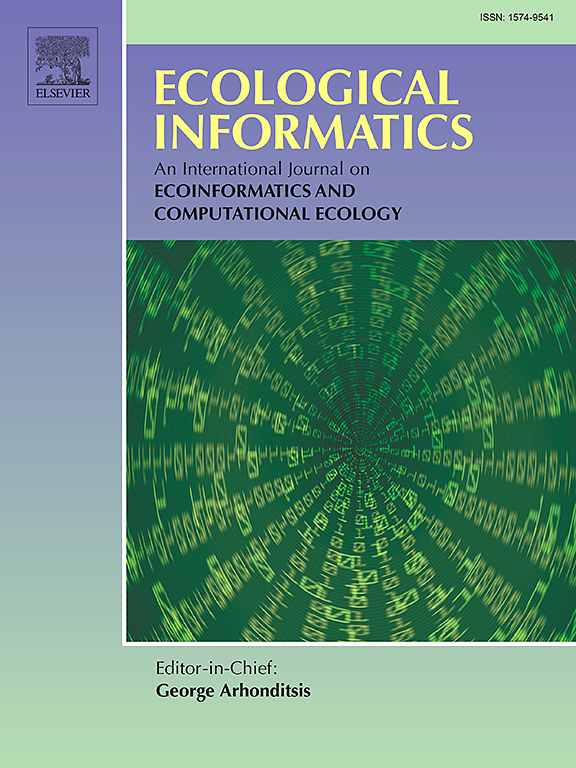Bayesian feedback in the framework of ecological sciences
IF 5.8
2区 环境科学与生态学
Q1 ECOLOGY
引用次数: 0
Abstract
In ecological studies, it is not uncommon to encounter scenarios where the same phenomenon (e.g., species occurrence, species abundance) is observed using two different types of samplers. For example, species data can be collected from scientific sampling with a completely random sample pattern, but also from opportunistic sampling (e.g., whale watching from commercial fishing vessels or bird watching from citizen science), where observers tend to look for particular species in areas where they expect to find them.
Species Distribution Models (SDMs) are widely used tools for analysing this type of ecological data. In particular, two models are available for the aforementioned data: a geostatistical model (GM) for data collected where the sampling design is not directly related to the observations, and a preferential model (PM) for data obtained from opportunistic sampling.
The integration of information from disparate sources can be addressed through the use of expert elicitation and integrated models. This paper focuses on a sequential Bayesian procedure for linking two models by updating prior distributions. The Bayesian paradigm is implemented together with the integrated nested Laplace approximation (INLA) methodology, which is an effective approach for making inference and predictions in spatial models with high performance and low computational cost. This sequential approach has been evaluated through the simulation of various scenarios and the subsequent comparison of the results from sharing information between models using a variety of criteria. The procedure has also been exemplified on a real dataset.
The primary findings indicate that, in general, it is preferable to transfer information from the independent (with a completely random sampling) model to the preferential model rather than in the alternative direction. However, this depends on several factors, including the spatial range and the spatial arrangement of the sampling locations.
生态科学框架下的贝叶斯反馈
在生态研究中,使用两种不同类型的取样器观测同一现象(如物种发生率、物种丰度)的情况并不少见。例如,物种数据可以通过完全随机抽样模式的科学采样收集,也可以通过机会主义采样(如商业渔船的鲸鱼观察或公民科学的鸟类观察)收集,观察者倾向于在他们期望发现特定物种的区域寻找特定物种。物种分布模型(SDM)是分析这类生态数据的广泛应用工具。特别是,有两种模型可用于上述数据:一种是地理统计模型(GM),用于收集采样设计与观测结果无直接关系的数据;另一种是优选模型(PM),用于从机会性采样中获得的数据。本文的重点是通过更新先验分布来连接两个模型的顺序贝叶斯程序。贝叶斯范式与集成嵌套拉普拉斯近似(INLA)方法一起实施,这是一种在空间模型中进行推理和预测的有效方法,具有性能高、计算成本低的特点。通过模拟各种情况以及随后使用各种标准比较模型之间共享信息的结果,对这种顺序方法进行了评估。主要研究结果表明,一般来说,从独立模型(完全随机抽样)向优先模型传递信息比向其他方向传递信息更可取。不过,这取决于几个因素,包括空间范围和采样地点的空间排列。
本文章由计算机程序翻译,如有差异,请以英文原文为准。
求助全文
约1分钟内获得全文
求助全文
来源期刊

Ecological Informatics
环境科学-生态学
CiteScore
8.30
自引率
11.80%
发文量
346
审稿时长
46 days
期刊介绍:
The journal Ecological Informatics is devoted to the publication of high quality, peer-reviewed articles on all aspects of computational ecology, data science and biogeography. The scope of the journal takes into account the data-intensive nature of ecology, the growing capacity of information technology to access, harness and leverage complex data as well as the critical need for informing sustainable management in view of global environmental and climate change.
The nature of the journal is interdisciplinary at the crossover between ecology and informatics. It focuses on novel concepts and techniques for image- and genome-based monitoring and interpretation, sensor- and multimedia-based data acquisition, internet-based data archiving and sharing, data assimilation, modelling and prediction of ecological data.
 求助内容:
求助内容: 应助结果提醒方式:
应助结果提醒方式:


